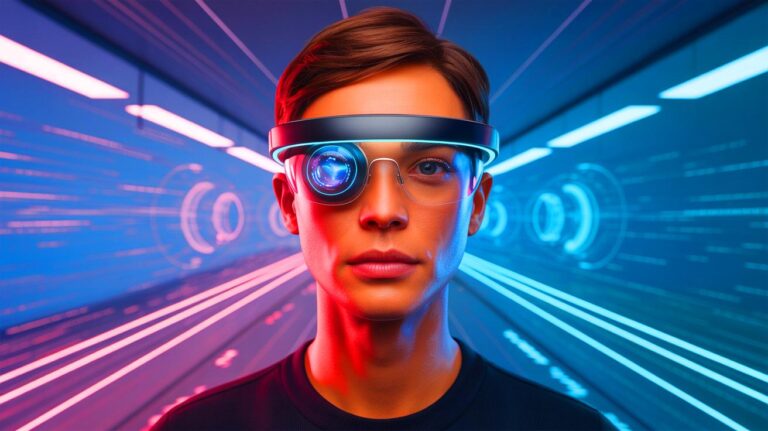In a Nutshell
- 🎨 Stanford and Meta Reality Labs have developed a groundbreaking VR display using holography, waveguides, and AI.
- 👓 The new 3D display is as thin as 0.12 inches and aims to integrate immersive experiences into everyday wearables.
- 🔍 AI-driven calibration enhances visual clarity and 3D realism, addressing core challenges in holographic optics.
- 🌐 The technology aims to achieve mixed reality, blending real and digital worlds seamlessly to pass the “Visual Turing Test.”
Revolutionizing Virtual Reality: A Breakthrough in Holographic Displays
The landscape of virtual reality (VR) is changing, thanks to innovative advancements that prioritize realistic, lifelike experiences. A notable leap forward comes from Stanford University and Meta Reality Labs, who have joined forces to create a state-of-the-art VR display. Leveraging the power of holography, waveguides, and artificial intelligence (AI), this new technology delivers immersive 3D visuals in a remarkably compact form, measuring just 0.12 inches thin. As wearable VR devices become more prevalent, this development could significantly reshape our interaction with digital environments.
Holography: A Game Changer in VR
Historically, VR technology has struggled with the bulkiness of headsets and a limited field of view. Traditional setups often rely on stereoscopic images to create depth perception, which can detract from the immersive experience. Holography offers a transformative solution. By rendering light fields more realistically, this technology enhances visual fidelity, allowing users to experience environments that feel genuine. The partnership between Stanford and Meta Reality Labs has produced a prototype that incorporates holography into a sleek, glasses-like design, marking a significant design and functional milestone.
Transformative Imaging Techniques
Unlike conventional VR systems, the new holographic display reconstructs the entirety of light fields, providing users with a more immersive experience. Utilizing a specialized waveguide alongside a spatial light modulator, it directly projects high-resolution holograms into the user’s eyes. This groundbreaking approach results in visuals that appear palpably real, significantly enhancing the VR experience. As noted by Gordon Wetzstein, a professor of electrical engineering at Stanford, “Holography delivers capabilities unattainable with existing display technologies in a far more compact package.”
AI-Driven Calibration for Enhanced Realism
A standout feature of this innovative VR display is its incorporation of AI technology to further improve immersion. The system’s AI-driven calibration method optimizes visual clarity and elevates the 3D realism of images. This integration tackles key challenges in holographic optics, such as maintaining a broad field of view while providing a comfortable eyebox. By doing so, users can move their eyes freely without compromising focus or image quality. This advancement is crucial for creating a seamless, immersive experience that feels genuinely interactive.
Comfort and Usability for Extended Use
The ultra-thin design of these glasses also prioritizes user comfort, allowing for long periods of use without eye or neck strain. Wetzstein emphasizes the need for a lightweight, comfortable device suitable for all-day wear, indicating a substantial step towards making VR technology more accessible and enjoyable. This focus on ergonomics could revolutionize how we engage with digital environments, paving the way for more widespread adoption.
Mixed Reality: The Future of Holographic Interaction
The overarching goal for this research is to achieve “mixed reality,” where digital holograms blend seamlessly with real-world views. This concept, often described as passing the “Visual Turing Test,” seeks to create experiences where users cannot distinguish between actual objects and digital projections. Building upon previous efforts in holographic waveguide technology, this new prototype is set to advance practical applications and potential commercialization.
Challenges Ahead and Future Prospects
Despite its groundbreaking nature, various challenges remain before this technology can be widely adopted. One of the primary hurdles is the cost of production, which must be addressed to make it accessible to a broader audience. Furthermore, ongoing research is necessary to enhance durability and energy efficiency. While the integration of AI and holography shows great promise, continuous improvement is essential for optimal performance and reliability.
The potential applications for this innovative VR technology span multiple sectors, from gaming and entertainment to education and telecommuting. As Stanford and Meta Reality Labs push the boundaries of what is possible in VR, the future of digital interaction appears incredibly promising. With each advancement, we move toward a reality where virtual and physical worlds coexist seamlessly, offering users extraordinary experiences and capabilities.
